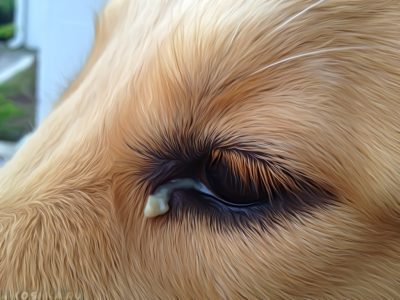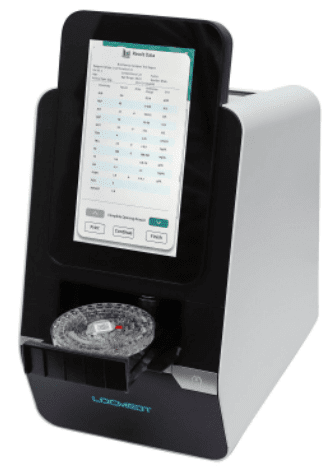
Општи и биохемијски тест крви код паса: дешифровање индикатора
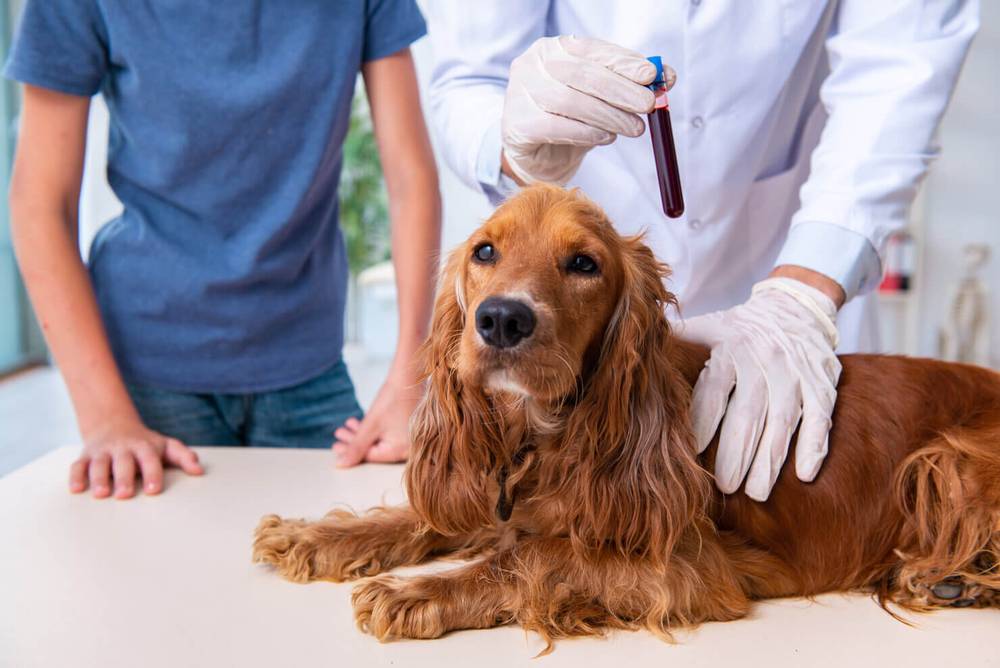
Садржај
Types of blood tests in dogs
There are many types of tests and blood counts in dogs, we will discuss the most important of them: the general clinical analysis (CCA) and the biochemical blood test (BC). An experienced clinician, by comparing the history and test results, can determine which direction to choose in the diagnosis and how to help the patient.
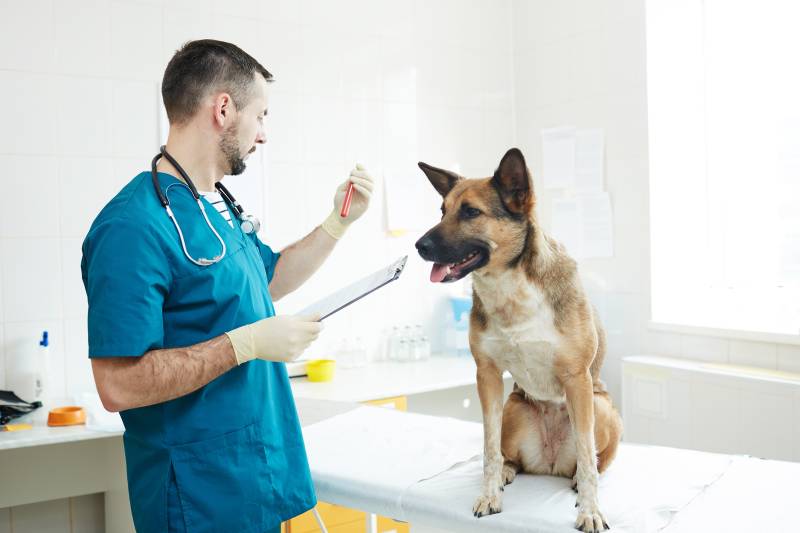
Општа анализа
A complete blood count in dogs will show signs of infection, the intensity of the inflammatory process, anemic conditions and other abnormalities.
Главни фактори:
Hematocrit (Ht) – the percentage of red blood cells in relation to the volume of blood. The more red blood cells in the blood, the higher this indicator will be. This is the main marker of anemia. An increase in hematocrit usually does not carry much clinical significance, while its decrease is a bad sign.
Hemoglobin (Hb) – a protein complex contained in erythrocytes and binding oxygen. Like hematocrit, it plays a major role in the diagnosis of anemia. Its increase may indicate an oxygen deficiency.
Red blood cells (RBC) – red blood cells are responsible for the transport of oxygen and other substances and are the most numerous group of blood cells. Their number closely correlates with the hemoglobin index and has the same clinical significance.
Leukocytes (WBC) – white blood cells are responsible for immunity, fighting infections. This group includes several types of cells with different functions. The ratio of different forms of leukocytes to each other is called leukogram and is of high clinical importance in dogs.
Neutrophils – are very mobile, able to pass through tissue barriers, leave the bloodstream and have the ability to phagocytosis (absorption) of foreign agents such as viruses, bacteria, protozoa. There are 2 groups of neutrophils. Stab – immature neutrophils, they have just entered the bloodstream. If their number is increased, then the body reacts sharply to the disease, while the predominance of segmented (mature) forms of neutrophils will indicate a chronic course of the disease.
Eosinophils – a small group of large cells, the main purpose of which is the fight against multicellular parasites. Their increase almost always indicates a parasitic invasion. However, their normal level does not mean that the pet does not have parasites.
Basophils – cells responsible for the allergic reaction and its maintenance. In dogs, basophils increase very rarely, unlike people, even if there is an allergy.
Monocytes – large cells that are able to leave the bloodstream and penetrate into any focus of inflammation. They are the main component of pus. Increased with sepsis (bacteria entering the bloodstream).
Lymphocytes – Responsible for specific immunity. Having met with an infection, they “remember” the pathogen and learn to fight it. Their increase will indicate an infectious process, they can also increase with oncology. A decrease will speak about immunosuppression, bone marrow diseases, viruses.
Platelets – non-nuclear cells, the main function of which is to stop bleeding. They will always rise with blood loss, as a compensatory mechanism. They can be reduced for two reasons: either they are excessively lost (thrombotic poisons, blood loss, infections), or they are not formed enough (tumors, bone marrow diseases, etc.). But often they are underestimated erroneously if a blood clot has formed in the test tube (research artifact).
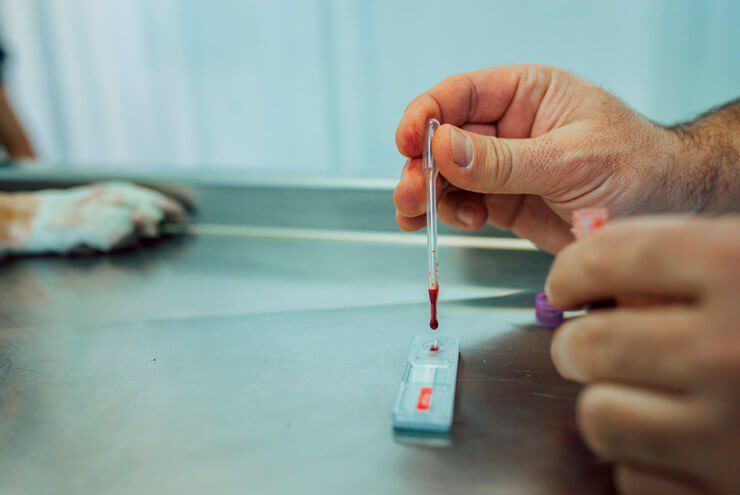
Биохемијска анализа
The biochemistry of a dog’s blood will help determine or suggest diseases of individual organs, but in order to correctly decipher the results, you need to understand the essence of each indicator.
Главни фактори:
Albumen is a simple, water-soluble protein. It is involved in a huge number of processes, from cell nutrition to vitamin transport. Its increase has no clinical significance, while a decrease may indicate serious diseases with protein loss or a violation of its metabolism.
ALT (alanine aminotransferase) An enzyme found in most cells of the body. Its greatest amount is found in the cells of the liver, kidneys, cardiac and muscle muscles. The indicator increases with diseases of these organs (especially the liver). It also occurs after injury (due to muscle damage) and during hemolysis (destruction of red blood cells).
AST (aspartate aminotransferase) – an enzyme, like ALT, contained in the liver, muscles, myocardium, kidneys, red blood cells, and the intestinal wall. Its level almost always correlates with the level of ALT, but in myocarditis, the level of AST will be higher than the level of ALT, since AST is contained in a larger amount in the myocardium.
Alpha amylase – an enzyme produced in the pancreas (PZh), for the breakdown of carbohydrates. Amylase, as an indicator, has little clinical significance. It enters the bloodstream from the duodenum, respectively, its increase may be associated with an increase in intestinal permeability rather than with diseases of the pancreas.
Bilirubin is a pigment found in bile. Increases in diseases of the hepatobiliary system. With its increase, the mucous membranes take on a characteristic icteric (icteric) shade.
GGT (gamma-glutamyl transferase) – an enzyme found in the cells of the liver, pancreas, mammary gland, spleen, intestines, but not found in the myocardium and muscles. An increase in its level will indicate damage to the tissues in which it is contained.
Glucose – simple sugar, used as a source of energy. Changes in its amount in the blood will primarily indicate the state of metabolism. Deficiency will most often be associated with its insufficient intake (during hunger) or loss (poisoning, drugs). An increase will indicate serious diseases such as diabetes, kidney failure, etc.
Creatinine is a protein breakdown product. It is excreted by the kidneys, so if their work is disturbed, it will increase. However, it can be increased with dehydration, injuries, non-observance of hunger before a blood test.
Urea is the end product of protein breakdown. Urea is formed in the liver and excreted by the kidneys. Increases with the defeat of these organs. Decreases in liver failure.
Alkaline phosphatase – an enzyme contained in the cells of the liver, kidneys, intestines, pancreas, placenta, bones. In diseases of the gallbladder, alkaline phosphatase almost always rises. But it can also be increased during pregnancy, enteropathy, diseases of the oral cavity, during the growth period.
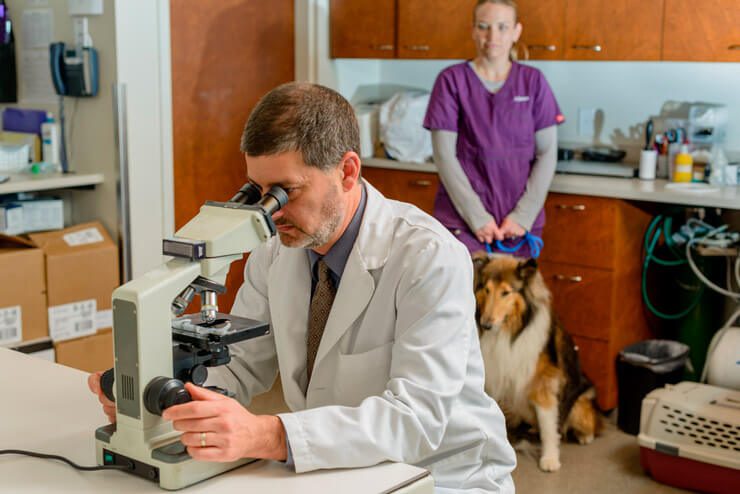
Norms of blood parameters
In general analysis
Table for deciphering the norms of indicators of a general blood test in dogs
| индекс | Adult dog, normal | Puppy, norm |
| Хемоглобин (г/Л) | 120-180 | 90-120 |
| Хематокрит (%) | 35-55 | 29-48 |
| Еритроцити (милиони/µл) | 5.5-8.5 | 3.6-7.4 |
| Леукоцити (хиљаде/µл) | 5.5-16 | 5.5-16 |
| Убодни неутрофили (%) | 0-3 | 0-3 |
| Сегментирани неутрофили (%) | 60-70 | 60-70 |
| Моноцити (%) | 3-10 | 3-10 |
| Лимфоцити (%) | 12-30 | 12-30 |
| Тромбоцити (хиљаде/µл) | 140-480 | 140-480 |

У биохемијској анализи
Norms of indicators of a biochemical blood test in dogs
| индекс | Adult dog, normal | Puppy, norm |
| албумин (г/Л) | 25-40 | 15-40 |
| ЗЛАТО (јединице/л) | 10-65 | 10-45 |
| АСТ (јединице/л) | 10-50 | 10-23 |
| Алфа-амилаза (јединице/л) | 350-2000 | 350-2000 |
| Директни билирубин Укупни билирубин (μмол/Л) | ||
| ГГТ (јединице/л) | ||
| глукоза (ммол/л) | 4.3-6.6 | 2.8-12 |
| уреа (ммол/л) | 3-9 | 3-9 |
| Креатинин (μмол/Л) | 33-136 | 33-136 |
| Алкална фосфатаза (у/л) | 10-80 | 70-520 |
| Калцијум (ммол/л) | 2.25-2.7 | 2.1-3.4 |
| Фосфор (ммол/л) | 1.01-1.96 | 1.2-3.6 |
Deviations in blood counts
Општа анализа
Deciphering a blood test in dogs
| индекс | Изнад норме | Испод норме |
| Хемоглобин Хематоцрит Еритроцити | Дехидрација Хипоксија (болести плућа, срца) Тумори БМЦ | Анемија хроничне болести Хронична болест бубрега Губитак крви Хемолиза Iron Deficit Болести коштане сржи Продужени пост |
| леукоцити | Инфекције (бактеријске, вирусне) недавни оброк Трудноћа Општи инфламаторни процес | Infections (eg, parvovirus enteritis) Имуносупресија Болести коштане сржи Крварење |
| Неутрофили су убодни | Акутна упала Акутна инфекција | - |
| Неутрофили су сегментирани | Хронична упала хронична инфекција | Болести КЦМ Губитак крви Неке инфекције |
| Моноцити | Инфекција Тумори Ране | Болести КЦМ губитак крви Имуносупресија |
| Лимфоцити | Инфекције Тумори (укључујући лимфом) | Болести КЦМ губитак крви Имуносупресија вирусне инфекције |
| Тромбоцити | Недавни губитак крви / повреда Болести КЦМ Дехидрација | Губитак крви Хемолитичке супстанце (тровања, неки лекови) Болести КЦМ Кршење преданалитике |

Биохемијска анализа
Deciphering a biochemical blood test in dogs
| индекс | Изнад норме | Испод норме |
| Албуми | Дехидрација | Инсуфицијенција јетре Ентеропатија или нефропатија са губитком протеина Инфекције Екстензивне лезије коже (пиодерма, атопија, екцем) Недовољан унос протеина Излив/едем Губитак крви |
| АЛТ | Атрофија јетре Недостатак пиридоксина | Хепатопатија (неоплазија, хепатитис, липидоза јетре, итд.) Хипоксија Тровање панкреатитис Повреде |
| АСТ | Атрофија јетре Недостатак пиридоксина | Хепатопатија Тровање / интоксикација Употреба кортикостероида Хипоксија повреда Хемолиза панкреатитис |
| Алфа амилазе | - | Дехидрација панкреатитис Бубрег Ентеропатије / руптура црева Хепатопатије Узимање кортикостероида |
| Билирубин | - | Хемолиза Болести јетре и жучне кесе |
| ГГТ | - | Болести јетре и жучне кесе |
| Глукоза | Изгладњивање Тумори сепса Инсуфицијенција јетре Касна трудноћа | Дијабетес Анксиозност/страх Хепатокутани синдром Хипертиреоза Инсулинска резистенција (са акромегалијом, хиперадренокортицизмом итд.) |
| Мокраћа | Инсуфицијенција јетре Губитак протеина Асцитес Изгладњивање | Дехидрација/хиповолемија/шок Бернс Отказивање бубрега и друга оштећења бубрега Тровање |
| Креатинин | Трудноћа Хипертиреоза Кахексија | Дехидрација/хиповолемија Бубрег Отказивање срца Висок унос протеина (храњење месом) |
| Алкална фосфатаза | - | Болести јетре и жучне кесе Терапија антиконвулзивима панкреатитис Млад узраст Стоматолошке болести Болести костију (ресорпција, преломи) Тумори |
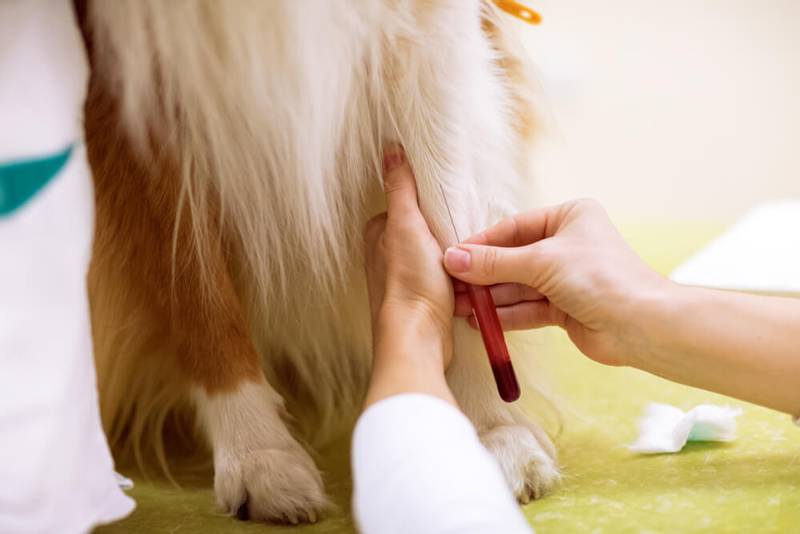
How to prepare a dog for the procedure?
The main rule before a blood test is to endure hunger.
For adult dogs weighing more than 10 kg, fasting should be 8-10 hours.
It is enough for small dogs to withstand hunger for 6-8 hours, they cannot starve for a long time.
For babies up to 4 months old, it is enough to maintain a hungry diet for 4-6 hours.
Water before analysis should not be limited.
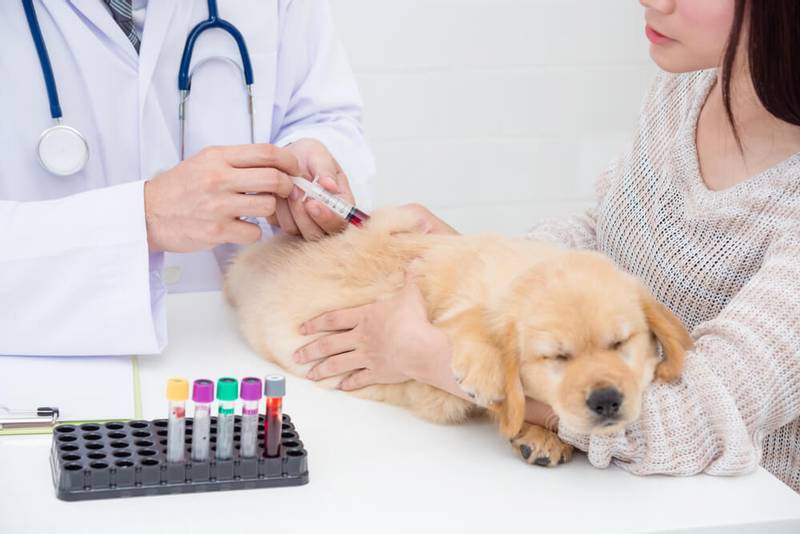
Како се вади крв?
Depending on the situation, the doctor may take an analysis from the vein of the front or rear limb.
First, a tourniquet is applied. The injection site of the needle is treated with alcohol, after which the blood is collected in test tubes.
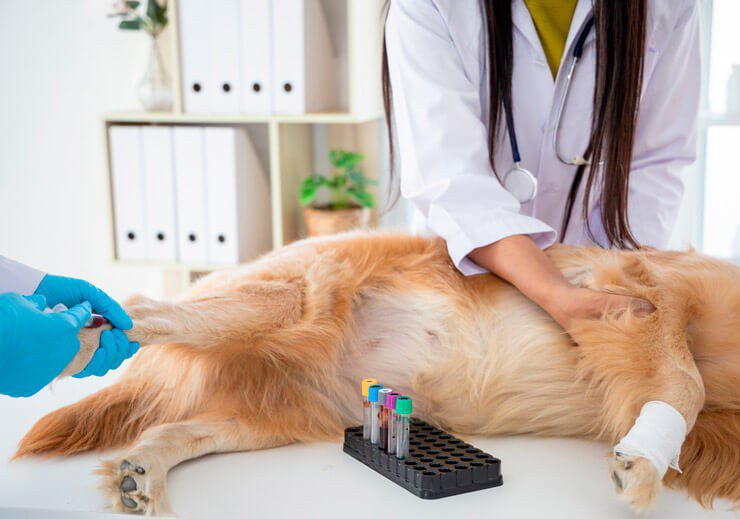
The procedure, although unpleasant, is not very painful. Animals are more likely to be afraid of a tourniquet than a puncture with a needle. The task of the owners in this situation is to calm the pet as much as possible, talk to him and not be afraid yourself, if the dog feels that you are afraid, he will be even more scared.
Одговори на често постављана питања
Октобар КСНУМКС КСНУМКС
Ажурирано: октобар КСНУМКС, КСНУМКС






